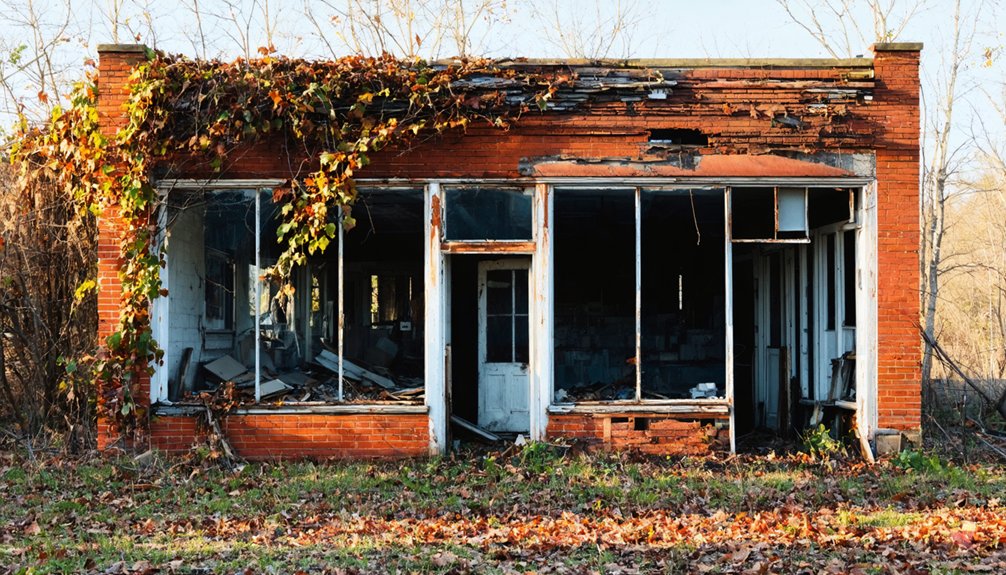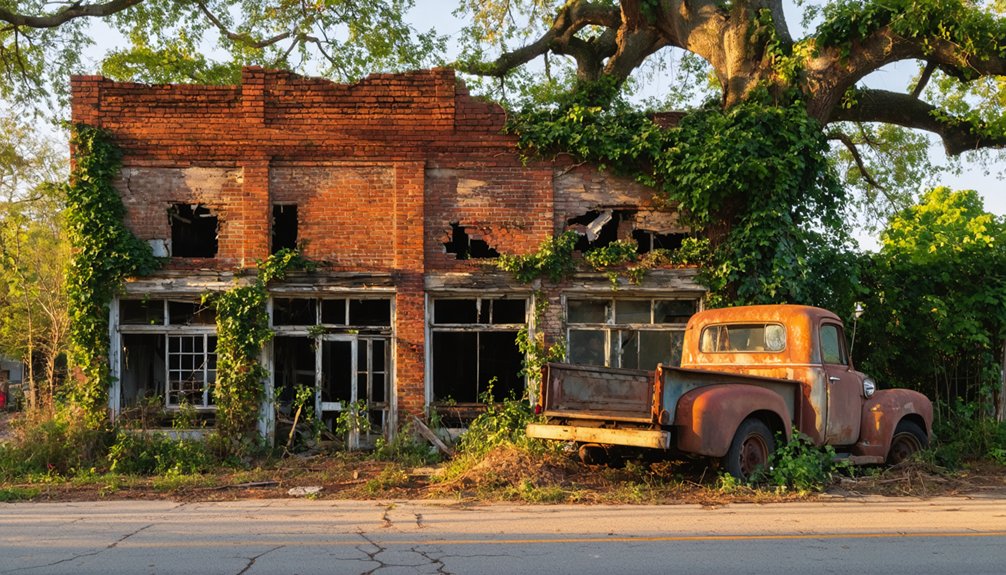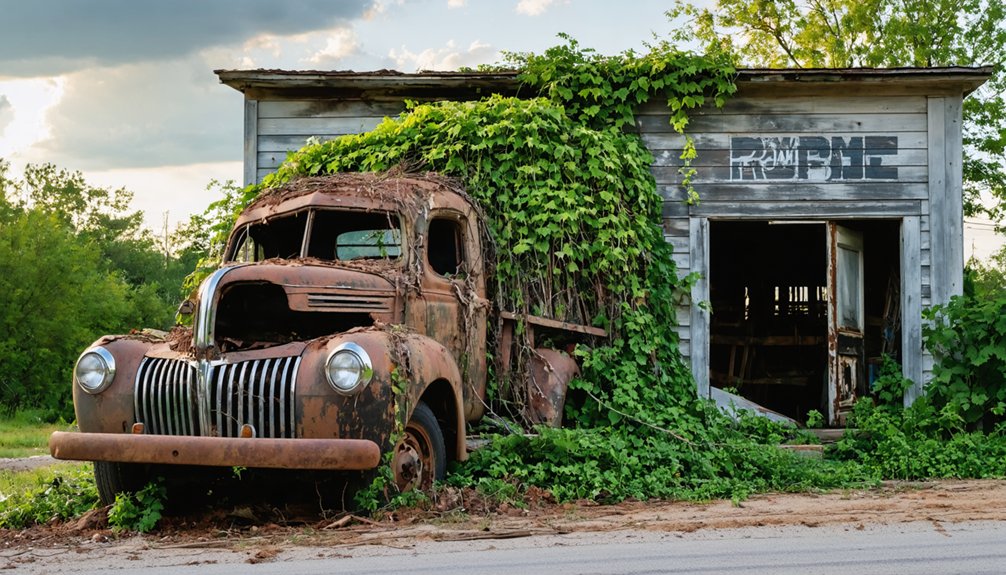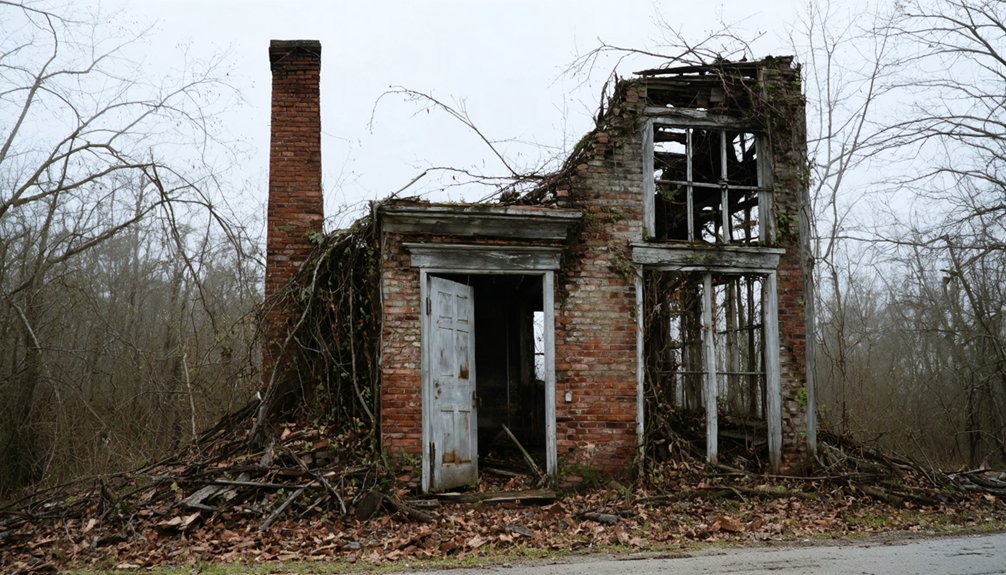You’ll find Barnesville, Alabama nestled in Marion County at coordinates 34°08′23″N 88°04′40″W, where two Baptist churches stand as the last remnants of a once-thriving agricultural settlement. The town flourished between 1855 and 1907, centered around cotton farming, local commerce, and strong religious traditions. While most structures have vanished, the churches’ preservation offers a compelling window into 19th-century rural life. The site’s architectural remnants and seasonal Decoration Day celebrations hold untold stories of Alabama’s past.
Key Takeaways
- Barnesville was an agricultural settlement in Marion County, Alabama that declined after being bypassed by rail lines and automobile routes.
- Two Baptist churches remain as the primary surviving structures, serving as physical evidence of the former community’s existence.
- Economic decline followed the Civil War and mechanization, leading to population loss as younger residents sought opportunities elsewhere.
- The town centered around agriculture, particularly cotton farming, with a post office and modest commercial activities supporting daily life.
- Annual Decoration Day celebrations continue on the third Sunday of May, preserving a connection to the ghost town’s history.
Early Settlement and Location
While many ghost towns in Alabama arose from mining or industrial ventures, Barnesville emerged as a modest agricultural settlement in Marion County at coordinates 34°08′23″N 88°04′40″W.
You’ll find this former community tucked away from major highways, situated off what’s now Alabama State Route 19, in a region that exemplifies the geographic isolation common to 19th-century rural settlements.
Unlike boom towns built around industry, Barnesville’s roots trace back to subsistence farmers who ventured westward during Alabama’s territorial expansion.
The settlement’s early agriculture focus shaped its development, with local families cultivating the land and establishing basic trade networks. Much like Capps, Alabama, Barnesville served as a vital shipping point for agricultural goods during its active years.
The area’s distance from major trade routes and mineral deposits meant you wouldn’t find the rapid growth typical of mining communities, but rather a steady, sustainable rural lifestyle. Similar to Fitzpatrick in Bullock County, the town maintained its rural character throughout its existence.
Church Heritage and Religious Life
The spiritual foundation of Barnesville centered on two Baptist churches that anchored the community’s religious life throughout its history. You’ll find both a Missionary Baptist and a Freewill Baptist church established during the mid-19th century, reflecting the dominant religious traditions of rural Alabama.
The church architecture stands as a symbol of their enduring presence, with both structures remaining among the few surviving buildings in Barnesville today. Today, the faithful still gather annually for Decoration Day celebrations on the third Sunday of May.
These churches served as more than just places of worship. They functioned as crucial hubs for community gatherings, fostering social connections and mutual support among residents. For accuracy in historical records, it’s important to note that this is Barnesville, Alabama specifically, as multiple locations share the Barnesville name.
Through circuit preachers and regional networks, they linked Barnesville to neighboring communities while providing educational opportunities and charitable outreach typical of small Alabama towns during that era.
Economic Activities and Trade
Reflecting its rural Alabama roots, Barnesville’s economic foundation rested almost entirely on agricultural activities throughout its inhabited years from 1855 to 1907.
You’ll find that cotton farming dominated the local economy, supplemented by subsistence crops that sustained the community’s residents. Like cotton distribution centers in Cahawba, local farmers transported their harvests to regional markets. Today, visitors can still see the remnants of two churches that remain standing among the scattered population.
Trade limitations greatly shaped Barnesville’s destiny. Without railroad connections or major waterway access, you’re looking at a settlement that relied solely on regional roads for market reach.
Isolated by limited transportation options, Barnesville’s economic reach never extended beyond the dusty regional roads connecting nearby communities.
The post office served as the primary hub for communication and local commerce until its closure. These infrastructure constraints, combined with widespread agricultural decline following the Civil War and increasing mechanization, ultimately sealed the town’s fate.
Unlike resource-rich ghost towns such as Gantts Quarry, Barnesville couldn’t diversify its economy beyond farming, leading to its eventual abandonment.
Daily Life in Rural Barnesville
You’d find daily life in Barnesville centered around its two Baptist churches, which served as the heart of community gatherings and social connections.
Your typical day would involve tending to farming duties like caring for livestock, maintaining gardens, and coordinating with neighbors for shared work activities.
You’d need to plan carefully for trading and commerce, as the scattered nature of homes and lack of formal roads meant relying on postal routes and personal vehicles to reach nearby towns for supplies and services.
Like many rural areas in Alabama during this time, residents relied on postal route codes rather than formal street names to navigate the region.
Residents took pride in their chicken farming heritage, as Alabama remains one of the nation’s top chicken producers today.
Church Life and Community
Religious life in Barnesville centered around two enduring churches – the Missionary Baptist and Freewill Baptist congregations – that served as crucial community hubs despite the town’s declining population. These churches hosted regular spiritual rituals and community gatherings that kept local traditions alive. Similar to the Gothic Revival style churches being built across Alabama in the 1850s, these houses of worship became architectural landmarks in the rural landscape.
You’ll find these churches played significant roles beyond Sunday worship:
- Serving as central meeting places for both white and enslaved African American populations, with recorded baptisms showing inclusive church life.
- Providing spaces for communal support and information exchange during rural hardships.
- Maintaining social bonds through hymn singing, sermons, and fellowship activities.
The modest wooden church buildings, though simple in design, featured traditional elements like wooden pews and potbelly stoves, creating warm sanctuaries where scattered residents could gather and preserve their shared identity.
Farming Family Activities
Beyond the church doors, Barnesville’s daily rhythm centered on its farming families, who shaped the town’s character through their agricultural pursuits.
You’d find families working together from sunrise to sunset, with farming techniques that evolved from simple plows to more advanced soil conservation methods. Everyone had their role – adults managed the demanding cycle of planting and harvesting, while children tended to livestock and helped with cotton picking. Like the Cates family descendants, these early settlers created lasting agricultural legacies through intermarriage and tight-knit farming communities.
Your daily activities would’ve varied with the seasons. During summer and fall, you’d focus on cotton harvesting and crop management.
Winter months meant preserving pork, repairing equipment, and planning next year’s rotations. Through innovative farming techniques like crop diversification and terracing, you’d maintain soil health while raising hogs, cattle, and growing corn, cotton, and vegetables to sustain your family’s livelihood.
Local Trading and Commerce
While Barnesville’s commercial scene remained modest in scale, the town’s vital businesses formed the backbone of daily rural life.
You’d find yourself maneuvering a tight-knit trading community where barter systems thrived alongside cash transactions. The grocery store and blacksmith shop served as your primary connection to local goods and services, while the two Baptist churches doubled as informal trading hubs during community gatherings.
- Your daily trading often involved face-to-face exchanges at the grocery store, where you’d acquire household essentials and share news.
- You’d rely heavily on the blacksmith for essential repairs to your farming equipment and transportation needs.
- You’d participate in seasonal trading of agricultural surplus with neighboring farms, strengthening community bonds through direct exchange.
The Path to Abandonment
As rail lines shifted and automobile routes bypassed Barnesville in the early-to-mid 20th century, the town’s once-strategic location became increasingly irrelevant.
You’d have witnessed the transportation decline gradually isolate this small Marion County community, cutting off essential supply chains and commercial opportunities that once sustained local businesses.
The population migration hit particularly hard as younger residents sought better opportunities in larger cities.
Without a new generation to maintain local institutions, you would’ve seen the town’s social fabric slowly unravel.
The two Baptist churches struggled to keep their doors open, while the blacksmith shop and grocery store – once bustling with activity – fell silent.
The absence of major industries or agricultural advantages left Barnesville unable to compete with neighboring towns that offered stronger economic prospects.
Present-Day Remnants

If you’re visiting Barnesville today, you’ll find two churches still standing as the most prominent remnants of this former Alabama community.
Among the scattered ruins, you’ll notice old homesite foundations peeking through vegetation, marking where residents once lived their daily lives.
These churches and foundations serve as the primary physical evidence of Barnesville’s existence, with most other structures having succumbed to time and abandonment.
Standing Churches Today
Two Baptist churches stand as the most prominent remnants of Barnesville’s religious heritage today: a Missionary Baptist and a Freewill Baptist church.
These traditional structures, with their rural church architecture, once served as essential community gathering spaces where locals would come together for worship and social events.
While showing signs of age, these churches remain standing as powerful symbols of Barnesville’s past.
You’ll find:
- Traditional wooden construction typical of rural Alabama churches
- Simple yet dignified designs that reflect the practical spirit of early settlers
- Historical significance as the last remaining structures of a once-thriving community
Though the town has largely faded into history, these churches continue to attract visitors interested in exploring Alabama’s ghost towns and preserving pieces of its religious heritage.
Scattered Homesite Foundations
Beyond the enduring church structures, scattered homesite foundations reveal Barnesville’s broader footprint across the landscape.
You’ll find stone and brick chimney bases marking former residences, while scattered artifacts like ceramics and glass fragments tell stories of daily life. The foundations vary in size, reflecting the economic diversity of Barnesville’s inhabitants.
Nature has steadily reclaimed these architectural remnants, with vegetation overtaking the masonry and soil gradually burying evidence of the past.
Foundation preservation ranges from clearly identifiable stone layouts to weathered rubble piles. The site of the former blacksmith shop anchors the settlement’s commercial center, while surrounding residential foundations paint a picture of a close-knit rural community.
Metal detector enthusiasts and relic hunters have occasionally disturbed these archaeological remains, though most sites remain relatively undisturbed.
Historical Significance in Alabama
Located along State Highway 19 in Marion County, Barnesville stands as a reflection of Alabama’s dynamic pattern of 19th-century settlement and decline.
As you explore the town’s cultural artifacts, you’ll find it mirrors the fate of many similar communities across the region. The presence of two Baptist churches and remnants of community buildings offers valuable insights into rural Southern life during the 1800s.
Consider these key aspects of Barnesville’s historical importance:
- The town’s preserved structures provide tangible evidence of religious and social organization in rural Alabama.
- Its decline reflects broader economic shifts that affected numerous settlements throughout the state.
- The site offers unique opportunities for regional comparison with other ghost towns, helping piece together Alabama’s settlement patterns.
Frequently Asked Questions
What Happened to the Original Church Records From Barnesville’s Two Baptist Churches?
You won’t find definitive proof of what happened to these church records. Despite typical Baptist church history and record preservation practices, there’s no evidence showing where Barnesville’s original documents ended up.
Are There Any Documented Paranormal Activities or Local Legends About Barnesville?
Despite thousands of ghost towns in Alabama, you won’t find documented haunted locations or local folklore about Barnesville. Unlike nearby towns with well-known paranormal stories, this settlement’s mysteries remain purely historical.
When Was the Last Recorded Birth or Death in Barnesville?
You can’t determine the last birth or last death with certainty due to lost records, courthouse fires in 1866 and 1883, and the post office’s closure in 1907 marking the end of official documentation.
Which Families Were the Last to Leave Barnesville?
You won’t find records of the last families who left during Barnesville’s exodus – historical documents don’t name specific households, though they confirm the town’s eventual complete abandonment over time.
Are There Any Surviving Photographs of Barnesville During Its Active Years?
You won’t find any surviving historical photographs of this community – no archival collections have surfaced containing images from its active period, despite extensive research of regional documentation.
References
- https://www.ghostlyworld.org/places/barnesville-alabama/
- https://kids.kiddle.co/Barnesville
- https://digitalalabama.com/article/alabama-ghost-towns/page/3
- https://en.wikipedia.org/wiki/List_of_ghost_towns_in_Alabama
- https://digitalalabama.com/alabama-maps/alabama-map-ghost-towns-of-alabama-map/9449
- https://www.ghostlyworld.org.dream.website/place-categories/towns-and-cities/
- https://pastmaps.com/explore/us/alabama/marion-county/barnesville/metal-detecting
- https://digitalalabama.com/alabama-ghost-towns/alabama-ghost-towns/9449
- https://www.travelawaits.com/2814768/best-historic-ghost-tours-alabama/
- https://en.wikipedia.org/wiki/Barnesville



